The best table grape varieties: descriptions, tastes and characteristics
Who doesn't like to enjoy crispy and juicy dessert berries? The fruits of table grapes have not only a bouquet of different tastes and aromas - from simple sweet to harmonious, from nutmeg to strawberry, but also a sufficient variety of peel and pulp colors, of which dark (black) varieties are considered the most useful for the body, which does not mean the need give up whites.
Of course, growing grapes on your site is not easy, especially if you have a fairly cold climate. However, there is no doubt that with the right agricultural technology and the choice of a suitable variety (usually early maturing), you will definitely succeed. And then you will find out which varieties of table grapes are the best and most popular in the summer cottages of many experienced winegrowers and amateur gardeners.After studying them, it will be easier for you to make a decision regarding the choice of the optimal variety that suits your desires (taste) and capabilities (care).
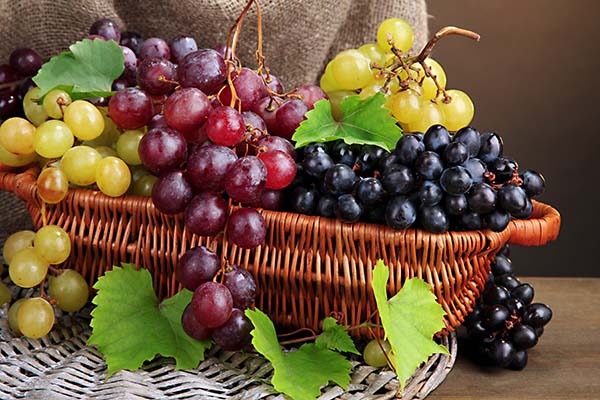
Content
The best and most popular white table grapes: top 10
Let's start with the light tones and move smoothly towards the dark ones. Therefore, to begin with, we offer you the best, moreover, time-tested, white varieties of table grapes:
Augustine (Pleven Stable, Phenomenon)
Obtained on the basis of crossing Vilan Blanc and Pleven varieties. Bulgarian selection.
The variety is vigorous, therefore suitable for growing on arches.
Forms weighty clusters in the shape of a cone, weighing 400-500 g (maximum up to 750-800 g).
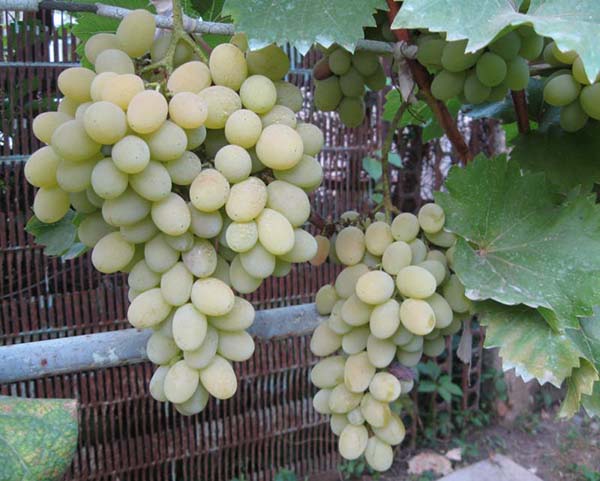
Has a green-yellow fruit color, slightly translucent in the sun. Augustine has a harmonious taste with an unobtrusive light aroma of nutmeg. Fruits are oval-elongated, about 27 mm long and 18 mm wide, weighing 4-7 g. The crispy pulp has a dense (fleshy) consistency, the rind is dense, thin.
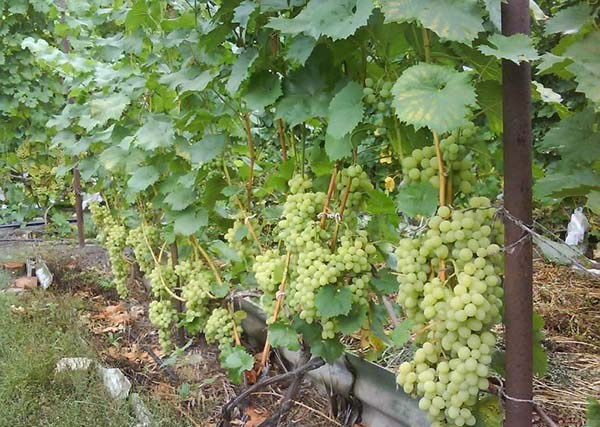
Characteristics of the Augustine variety:
- ripening period - 115-125 days (early);
- yield - 120-140 c / ha:
- sugar content - 17-19 g / l;
- acidity - 6-7 g / l;
- preservation on the crop bush - 2-3 weeks;
- the number of clusters on a fruitful shoot - 1.2-1.6;
- the number of fruitful shoots - 75-85%;
- eye load - 35-50;
- pruning vines is necessary for 8-12 eyes.
- frost resistance up to -22 ..- 24 degrees;
By the way! Augustine is great for creating a gazebo.
Advantages:
- High tasting score (8.2 points).
- The flowers are bisexual, so pollination is good, even under unfavorable conditions.
- Stable high yield.
- Relative unpretentious care.
- High transportability and marketability.
- High resistance to fungal diseases (2-2.5 points).
Disadvantages:
- Berries crack when the soil is too moist.
- It is susceptible to defeat by a grape-screwdriver, wasps.
- Often affected by gray rot.
Aleshenkin (Alyosha)
The variety was obtained by crossing Madeleine Angevin and a mixture of oriental pollen. Volgograd selection.
Medium and vigorous bushes.
Forms large brushes of a loose structure with a conical shape, with an average weight of 350-500 g (maximum up to 2 kg).
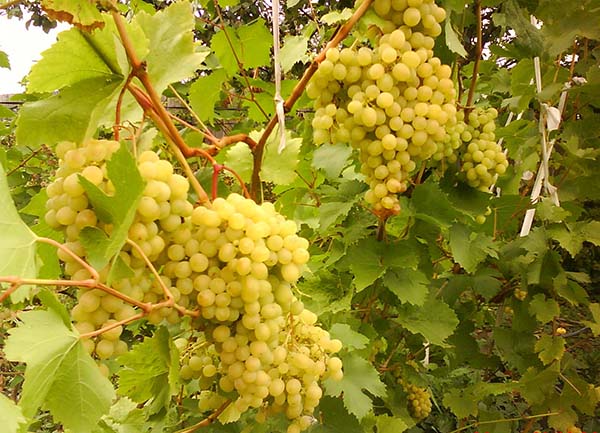
Has an amber hue with a white coating over the skin. Sufficiently small oval fruits, their weight reaches 3-5 g. The skin is thick. The pulp is crispy and juicy, with a pleasant sweet taste.
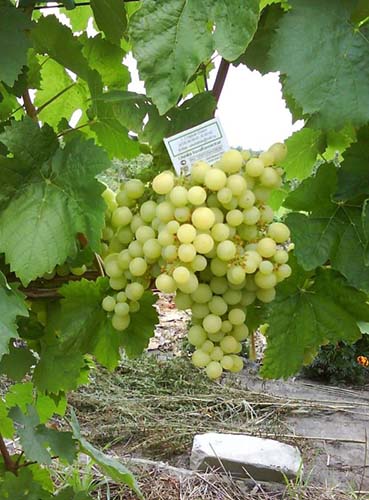
The main characteristics of the Aleshenkin variety:
- ripening period - 100-115 days (very early or very early);
- yield - 8-10 kg per bush.
- acidity - 3-6 g / l;
- sugar accumulation - up to 17-20%;
- eye load - 30-40;
- the recommended pruning is for 8-10 eyes (but you can also for a short one - 5-6 eyes).
- frost resistance up to 22 ..- 26 degrees.
Benefits:
- Very high tasting score (8.8 points).
- Consistently high yield.
- Amicable ripening of berries.
- Flowers are bisexual.
- High percentage of rooting cuttings.
Disadvantages:
- Susceptible to fungal diseases.
- Prone to peas.
- Ripening of the vine is satisfactory.
- It is prone to overload, therefore, it requires mandatory rationing (1 brush per 1 shoot).
Arcadia
The variety was bred by crossing the Cardinal, which is responsible for the taste of the prototype, and Moldova, which has resistance genes. Selection IV&V them. V.E. Tairova (Ukraine).
By the way! Arcadia is also sometimes called Nastya.
Arcadia is distinguished by large dense bunches, with an average weight of 500-700 g (maximum - 2-2.5 kg). Their shape is cylindrical-conical, with blades.
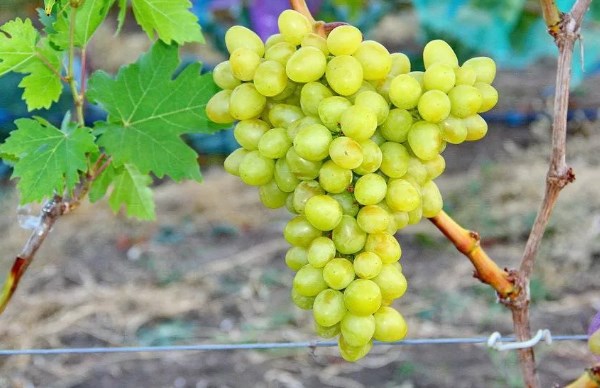
Arcadia berries are characterized by an unobtrusive, simple, but pleasant taste, which, when ripe, acquires a light aroma of nutmeg. The color is uniform white, the size reaches 23 by 28 mm (egg-shaped), the weight is 7-10 g (maximum up to 15 g), depending on the care and agricultural technology (load of the bush). The pulp is dense with a juicy consistency, and the skin is strong, which makes it possible to transport with a minimum percentage of damage.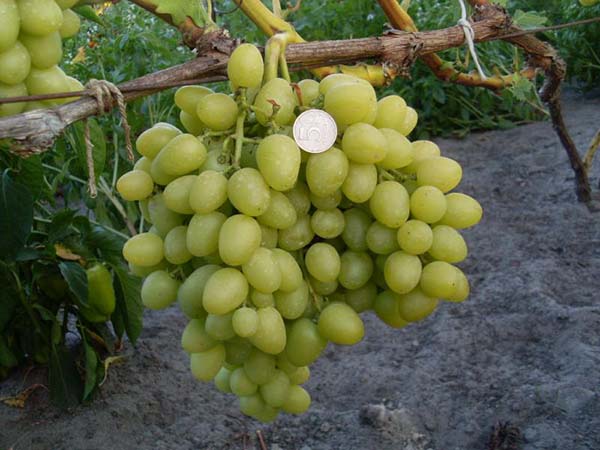
Characteristics of the Arcadia variety:
- ripening period - 115-125 days (early);
- sugar accumulation (sugar content) - 15-16%;
- acid level (acidity) - 4-6 g / l;
- fertility coefficient (number of clusters on a fruitful shoot) - 1.1-1.6;
- the ratio of fruitful shoots is 60-75%;
- yield - from 20 to 50 kg per bush;
- the load of the eyes on the bush when pruning is 30-50;
- pruning is recommended - for 8-12 eyes;
- frost resistance up to -21 ..- 23;
Note! Arcadia is distinguished by medium or fast growth of shoots and amicable ripening of fruits, which makes it possible to get the first full-fledged harvest already in the 3rd year of cultivation.
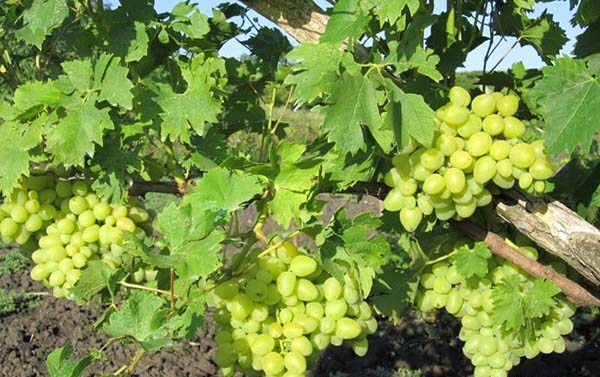
Advantages:
- Excellent tasting performance (8 points).
- Not bad resistance to mildew (3-3.5 points).
- Quite good resistance to gray mold (2.5-3.5 points).
- Wasp is hardly damaged.
- No peas.
- High percentage of rooting cuttings.
- Compatible with many rootstocks.
- High transportability and marketability.
Minuses:
- Cracking during waterlogging of the soil.
- When overloaded with brushes, the ripening of the shoots worsens.
- Susceptible to powdery mildew.
Delight White (Delight)
This variety is obtained by combining the qualities of Zori Severa and Dolores, as well as Russian early. Breeding VNIIViV them. Ya.I. Potapenko (Russia).
Bushes are medium to vigorous.
By the way! It has established itself well as an arched culture, i.e. can be grown on gazebos.
The bunches can be shapeless, or they can take the shape of a cone, their weight varies within 600-800 g (maximum up to 2 kg), depending on the cultivation technique.
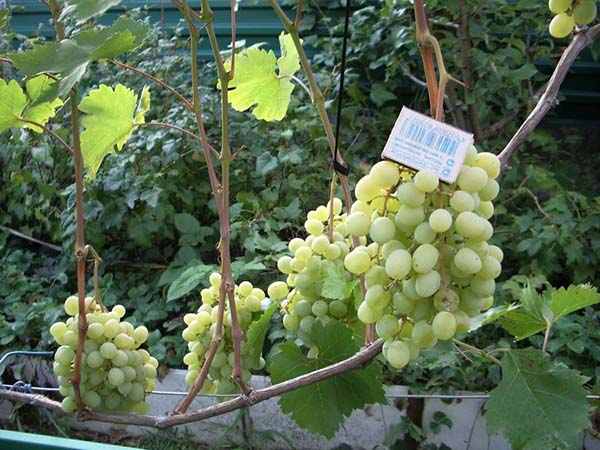
The fruits have a light creamy shade with a slight blush on the skin from the sunny side. The fruits are large, their weight is 5-8 g. The taste is harmonious. It has a crispy, dense pulp with a thin skin, which is almost imperceptible when consumed (eaten).
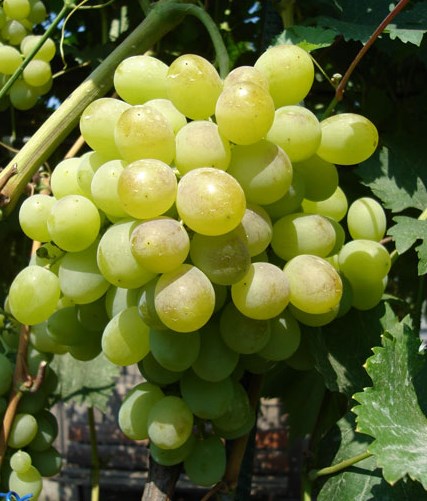
The main characteristics of the White Delight variety:
- ripening period - 110-120 days (very early or early);
- sugar ratio - 19-26%;
- acid content - 5-9 g / l;
- the rate of fruitful shoots is 65-85%;
- the number of clusters per shoot - 1.4-1.7;
- the optimal load of the eyes is 35-45;
- trimming can be 6-10 eyes (but you can also trim 2-4);
- frost resistance up to -25 degrees.
Advantages:
- The tasting indicator is 8.6 points.
- Differs in bisexual flowers.
- Relative resistance to mildew (3-3.5 points) and high - to gray rot (2 points).
- Very good maturation of the vine.
- It can hang on the vine for a very long time and not deteriorate (up to 1-1.5 months).
- The cuttings take root quickly.
- Wasps are not damaged.
- Does not lose its commercial qualities during transportation.
Minuses:
- May be sick with powdery mildew.
- Susceptible to phylloxera.
- Needs vigorous rootstocks.
Kesha White (Delight Superior)
The variety was bred by crossing the variety Vostorg and Frumoasa Albe. Breeding VNIIViV them. ME AND. Potapenko (Russia).
Bushes are vigorous.
The clusters are cylindrical-conical or conical, often shapeless, of medium density. The average weight is 600-900 g.
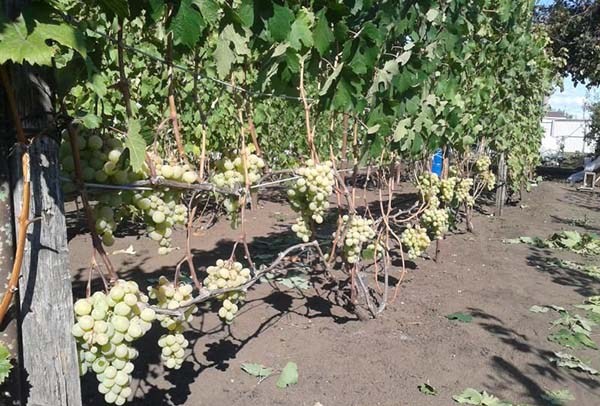
The berries are of a uniform amber-white color. Fruits are very large, oval, length up to 32 mm, width up to 24 mm, average weight 10-12 g, some up to 20 grams. Kesha is characterized by a dense texture with a pleasant taste. Seeds per fruit - 1-3.
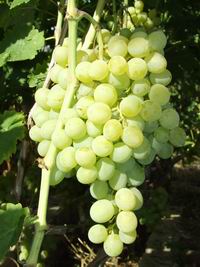
Characteristics of the Kesha variety (Improved Delight):
- ripening period - 120-130 days (early or early middle);
- sugar accumulation - 19-24%;
- the amount of acids is 5-8 g / l;
- the ratio of fruitful shoots is 65-80%;
- the number of bunches - 1.2-1.6;
- eye load - 35-40;
- needs to be trimmed for 8-12 eyes.
Advice! Kesha will bear fruit better on strong formations with a large supply of perennial wood.
- frost resistance up to -23 degrees.
Benefits:
- Tasting qualities (8.0 points).
- Has flowers of both sexes.
- Highly resistant to mildew.
- Shoots ripen well.
- High percentage of rooting cuttings.
- Never peas.
- It can hang without loss of taste until the very frost.
- High transportability.
Disadvantages:
- With a strong load on the brushes, the berries become smaller.
- He does not like frequent temperature changes and icing of the vines, because of this, the buds are vomited.
Important! Do not over-feed with nitrogen fertilizers.
Laura (Flora)
The species was obtained by crossing a mixture of pollen from Muscat Hamburg and Husayne, Muscat de Saint-Vellier, Queen Tairovskaya and a mixture of pollen from Central Asian varieties. Selection IV&V them. V.E. Tairova (Ukraine).
Laura is a medium to vigorous shrub that does not pick up very well. When pinching, it is imperative to leave 1-2 leaves, otherwise the buds intended for growth next year will start to grow.
Forms conical clusters of predominantly loose structure weighing up to 1 kg (on average 600-800 grams).
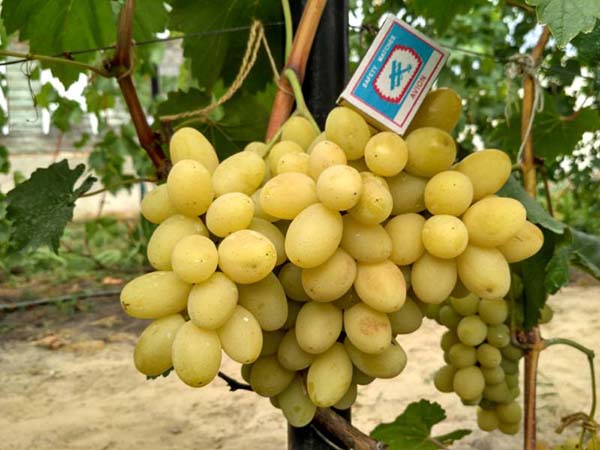
The color is light green with white prune; in the sun, the fruits acquire a light tan. The berries are either cylindrical or oval, sizes - 30 by 22 mm, weight - 6-10 g. The flesh is crispy, the seeds are large. The rind is firm but thin. The fruits are firmly attached to the stalk, so the bunches do not crumble. The taste of grapes is unobtrusively pleasant (accentedly oriental).
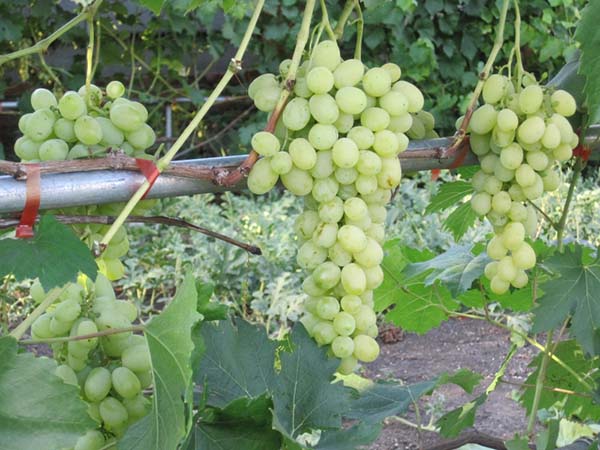
Characteristics of the variety Laura (Flora):
- ripening period - 110-115 days (very early);
- sugar accumulation - about 20% or more (up to 23%);
- acidity - 5-8 g / l;
- the number of fruitful shoots - 60-80%;
- the number of bunches per fruitful shoot - 1.3-1.5;
- eye load - 40-50;
- vines can be cut medium by 5-6 eyes or short by 2-4.
Note! The variety is not picky about care and is flexible to climatic conditions.
Benefits:
- High tasting score (8.9 points).
- Flowers are predominantly female, but pollinated well and the ovary occurs evenly.
- Good vine maturation.
- Cracking of the fruit is extremely rare.
- Relative resistance to mildew (3 points).
- Not affected by gray mold.
- High resistance to phylloxera.
- Not peas.
- Can hang on bushes for a long time and accumulate sugar.
- Not damaged during transportation.
- Excellent marketable berry.
Advice! The use of gibberellin lengthens the berries and produces seedless grapes.
Minuses:
- Sometimes it is affected by powdery mildew.
- Berries, due to the high percentage of sugar, are often damaged by wasps.
By the way! If you use vigorous rootstocks, you can achieve larger berries, but the ripening period will slightly increase and sugar accumulation will decrease.
Monarch (Chrysolite)
The hybrid was obtained by crossing the Talisman and Cardinal varieties with a mixture of pollen. Amateur selection E.G. Pavlovsky.
The bunches are very elegant and quite large - 500-600 g (there are also 1.5 kg).
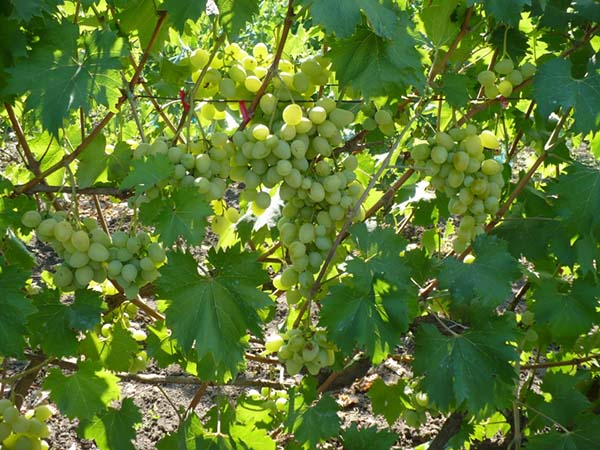
The berries are oval, white-yellow, in the sun with a red tan. Large, measuring 36 by 26 mm, weighing 15-20 grams. The pulp is dense, the skin is easily eaten. The taste is harmonious, with a delicate nutmeg aroma. 1-2 small seeds per berry.
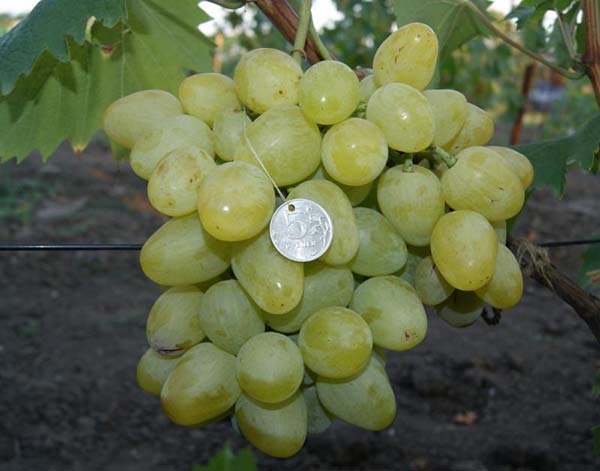
Characteristics of the Monarch variety:
- ripening period - 120-125 days (early);
- frost resistance up to -25 degrees.
Advantages:
- The flower is bisexual.
- No peas.
- The crop is preserved for a long time on the bushes without loss of marketability.
- Shoots ripen well.
- Increased resistance to diseases: mildew, oidium, gray mold (2 points).
Disadvantages:
- Damaged by wasps.
- Poorly pollinated and often the ovary crumbles before flowering.
It is necessary to remove the leaves until the inflorescences fully open so that they do not interfere with pollination in windy weather.
- Careful care and proper cultivation techniques are required.
Important! Chrysolite should not be allowed to "fatten", it should not be normalized before flowering. Also, do not remove unnecessary and unnecessary shoots until it fades and the berries are pea-sized.
Super Extra (Citrine)
The grape variety obtained by crossing the Cardinal with a mixture of pollen and Talisman. Amateur selection E.G. Pavlovsky.
Forms vigorous plants.
The size of the clusters is large, and their average weight is 500-800 g (up to 1 kg). The shape can vary from conical to cylindro-conical with or without one wing, and the structure is medium dense or loose, depending on the conditions during pollination.
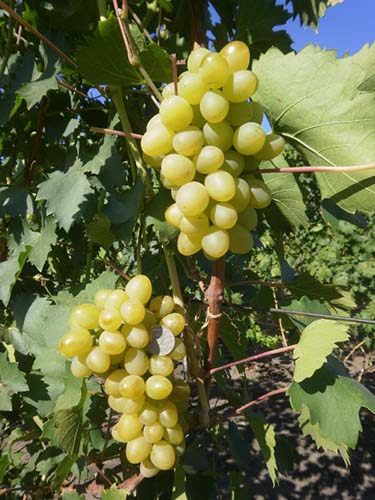
The berries are light green in color with a golden sheen. Super Extra's fruits are round (egg-shaped), large in size (size 25 by 21 mm) and weighing 7-13 g. Their taste is harmonious (light nutmeg aroma), the pulp is juicy and dense (fleshy), the rind is medium thick.
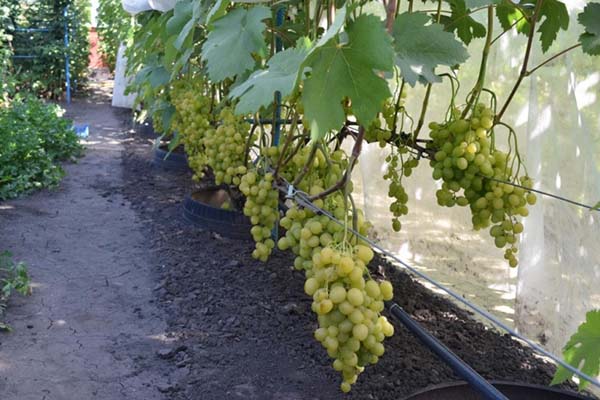
Characteristics of the Super Extra variety:
- ripening period - 100-110 days (very early or very early);
- sugar accumulation - 10%, but sometimes 16-19%;
- acid content - 5-6 g / l;
- frost resistance up to -23 ..- 25 degrees.
Important! Super Extra is prone to peas, so it is recommended to pinch before flowering, and you should not thicken the plantings so that the fruit zone is well ventilated.
Advantages:
- High and stable yield.
- Differs in bisexual type of flowers.
- It persists for a long time on the bushes.
- The vine ripens perfectly.
- Has a decent presentation.
- Not afraid of transportation.
- Resistance to mildew is high, to powdery mildew - medium.
Minuses:
- Prone to peas.
- Unstable against gray mold.
- It is prone to overload, therefore it is necessary to normalize.
- It is unstable to phylloxera.
Talisman (Kesha-1)
The variety is based on the basic qualities of the Rapture and Frumoasa Albé varieties. Selections VNIIViV named after Ya. Potapenko (Russia).
Forms vigorous bushes capable of early fruiting
The bunches are generally of medium density, sometimes they are loose. Their shape resembles a cone, the mass of an average brush is about 800-1200 g.
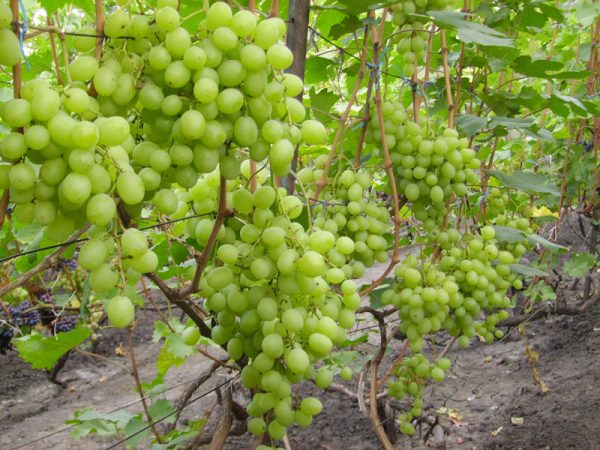
Fruits are white in color; in the sun they acquire a yellow blush. The size of the berries is large, round shape, length - 35 mm, width - 31 mm, weight - 12-16 g. The taste of grapes is harmonious with a nutmeg note (when fully ripe), very sweet and juicy. There are 1-2 seeds in the berry.
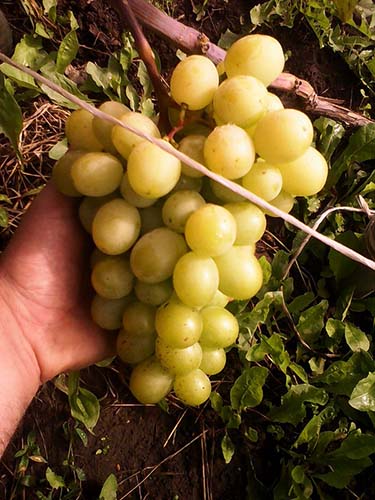
Characteristics of the Talisman variety:
- ripening period - 125-135 days (early middle);
- sugar accumulation - 17-23%;
- acid content - 6-8 g / l;
- fruitful shoots - 75-90%;
- the coefficient of bunches per escape is 1.4-1.8;
- optimal load - 35-45 eyes;
- recommended trimming for 12 eyes;
- frost resistance up to -25 degrees.
Advantages:
- High tasting score (8.5 points).
- High level of sugar accumulation.
- It can hang on a bush for a long time without loss of taste before frost.
- Not damaged in transit.
- Increased resistance to mildew and gray mold.
- Peas are insignificant.
- Not damaged by wasps.
- The flowers are female, but pollinated well.
- The rooting rate of cuttings is very good, the seedlings are vigorous.
Disadvantages:
- On one shoot, 2-3 inflorescences can form, therefore, it needs to be rationed.
Timur
When crossed, the hybrid absorbed the best qualities of the Frumoas Albe and Delight varieties. Breeding VNIIViV them. ME AND. Potapenko (Russia).
Forms a weak and medium vigor of plant growth, therefore it is not recommended to plant with vigorous crop species.
Forms cylindro-conical or simply conical clusters weighing 400-600 g, their structure varies from moderately loose to moderately dense.
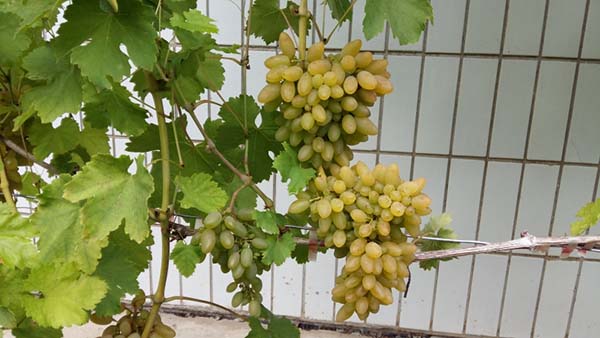
The fruits are white-amber in color with a slight brown tan. Timur's berries are large, 29 by 21 mm in size, resembling an oval in shape with a pointed tip (nipple), weighing 6-9 grams.The pulp is crunchy, with harmonious taste, in which there is a slight nutmeg hue, but more often the taste is rather tart. The peel of the fruit is thin, torn, not perceptible when consumed.
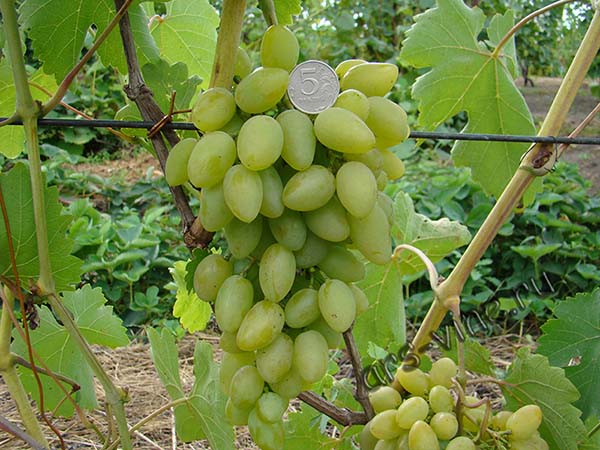
Characteristics of the Timur variety:
- ripening period - 105-115 days (very early);
- sugar content - 17-22%;
- acid content - 6-9 g / l;
- fruitful shoots - 80-90%;
- the ratio of bunches per shoot is 1.5-2;
- optimal load - 30-40 eyes;
- pruning shoots can be used as long - for 8-12 eyes, and short - for 2-4;
- frost resistance up to -25 degrees.
Note! Growing Timur on vigorous rootstocks has a positive effect on the quantity and quality of the crop, but at the same time the ripening of fruits slows down.
Pros:
- Has bisexual flowers.
- Easily propagated by cuttings.
- Begins to bear fruit quickly.
- High index of resistance to mildew and gray rot.
- Good vine maturation.
- It can hang until it gets cold (with almost no sugar loss).
Minuses:
- Peas happen.
- Wasps are often interested.
- Poorly tolerates transportation.
Interesting! More information about other white grape varieties you'll find here.
The best and most popular pink table grapes: top 10
Perhaps the most beautiful table grape is its pink (red) variety. After all, they not only taste great, but will also decorate your garden, filling it with unusual colors.
So, the following varieties of culture are usually called the best pink table grapes:
Anyuta
A hybrid form of culture, obtained on the basis of Talisman (Kesha-1) and Radiant Kishmish. Amateur selection V.N. Krainova.
A variety of high vigor.
Anyuta forms large brushes weighing 700-800 grams (maximum up to 1.5 kg) of medium friability.
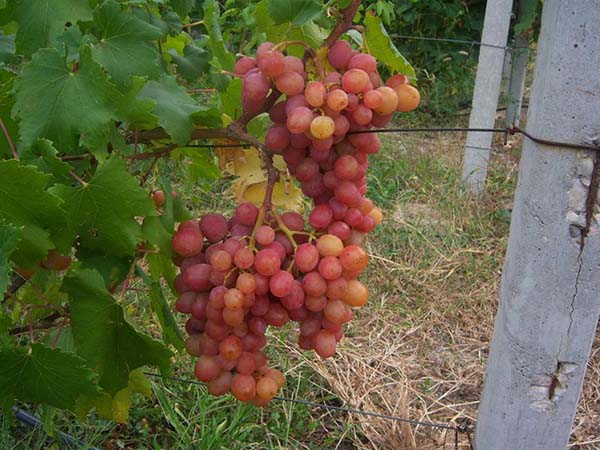
The fruit should be dark pink in color. Berries are oval, large, weighing 10-15 g (sometimes up to 20 g). The flesh is fleshy and the rind is firm. The variety is characterized by a subtle nutmeg aroma.
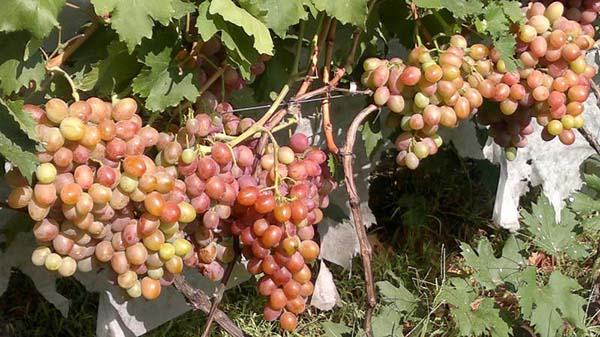
Characteristic features of Anyuta:
- ripening period - 140 days (medium or medium late);
- sugar accumulation - 18-50%;
- acid content - 5-7 g / l;
- fruiting rate - 1.3;
- eye load - 30-50;
- recommended pruning - 8-10 eyes;
- frost resistance up to -22 ..- 23 degrees.
Advantages:
- It has bisexual flowers, which gives stable pollination.
- The fruits do not crack even when the soil is waterlogged.
- Not prone to peas.
- Wasps are not damaged.
- Compatible with any rootstock.
- Good rooting of cuttings.
- Relative (average) resistance to mildew and oidium (3-3.5 points).
- Good vine maturation.
- Not damaged in transit.
Disadvantages:
- It is necessary to adjust the load, because prone to overload.
- There is often uneven ripening and color of the berry.
Victor
Bred by amateur winegrower V.N.Krainov (Transfiguration and Jubilee of Novocherkassk are also his varieties).
The variety is medium or vigorous.
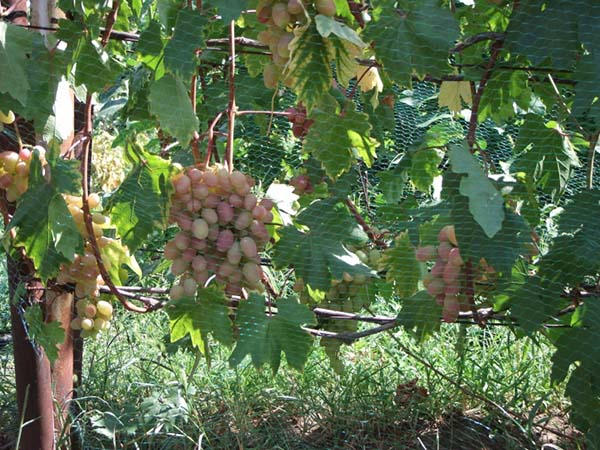
Grape clusters are large (up to 2 kg) or medium in size, weighing 500-1000 grams, medium density.
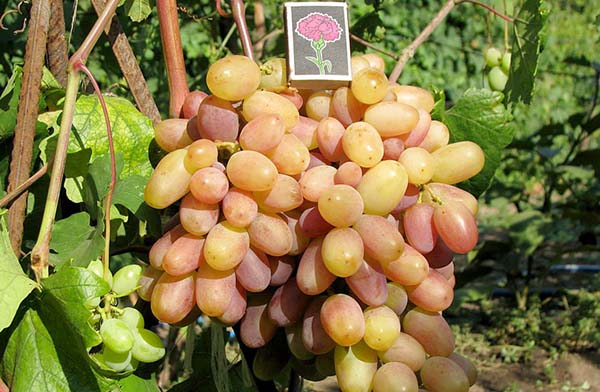
The color changes as the fruit ripens from pink-amber to red-lilac. Fruits in the form of an elongated oval with a pointed end. Very large, their weight is about 9-15 g (maximum up to 20 grams), and their length is about 50 mm. The taste is pleasant, the pulp is fleshy and juicy, with an average density. Victor has a thin edible rind.
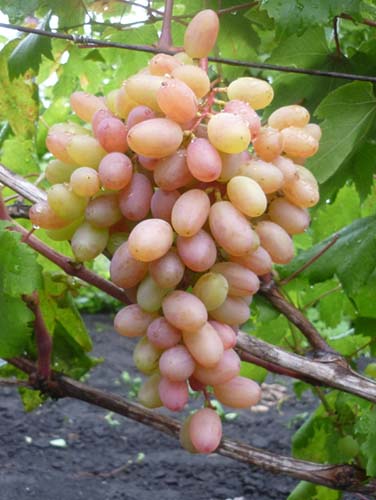
Characteristics of the Victor variety:
- ripening period - 100-110 days (very early or very early);
- sugar content - up to 17 g / l;
- acid content - 8 g / l;
- the maximum load of the eyes is 30-40;
- trimmed into 8-10 eyes;
- frost resistance up to -23 degrees.
Advantages:
- Bisexual flowers.
- Yield stability.
- Not prone to peas.
- Shoots ripen well.
- Excellent presentation.
- Good resistance to common fungal diseases (mildew, oidium, gray mold).
By the way! Victor forms many stepchildren, which makes it possible to get a second crop on new shoots.
Disadvantages:
- Very early flowering period, which increases the likelihood of damage to inflorescences in the event of late spring frosts.
- Attractive to wasps.
- It is necessary to graft on vigorous rootstocks.
Dubovsky pink
Obtained by crossing the varieties Red Delight and Yubiley Novocherkassk. Amateur selection Gusev S.E.
The growth force of the bushes is very high. The flower is bisexual.
Bunches are large and very large, weighing 500-800 g (individual up to 1200-1500 g), conical or branched, elongated, drooping, loose, rarely very loose or medium density.
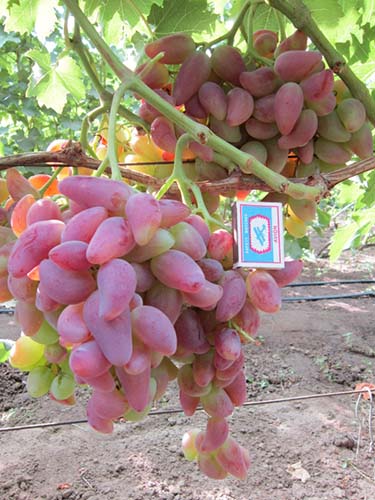
The berries are dark pink, very large, elongated-oval with a pointed tip, weighing 14-16 g. The pulp is dense, fleshy-juicy, the taste is harmonious. The peel is of medium thickness and density.
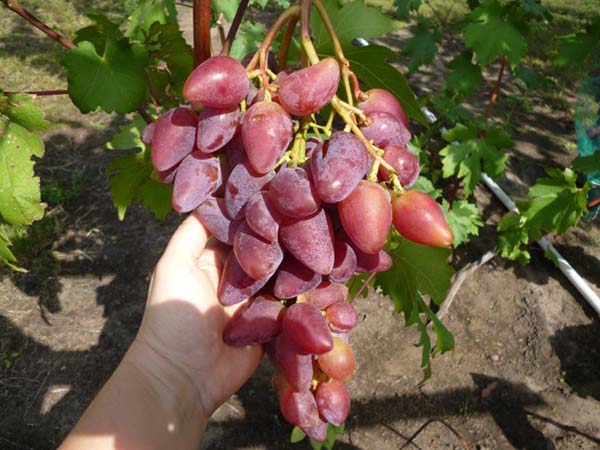
Characteristics of the variety Dubovsky pink:
- ripening period - early;
- sugar content of juice - 16-18 g / 100 cm3;
- acidity - 4-6 g / dm3;
- pruning vines for fruiting - 6-8 eyes (average);
- frost resistance up to -24 degrees.
Advantages:
- High tasting score (9.3 points).
- Transportability is good.
- The yield is high.
Advice! It is recommended to use pinching to improve the presentation of the bunches.
Disadvantages:
- Ripening of shoots is satisfactory.
- Requires rationing of bushes with inflorescences.
- Poorly gaining color in the south.
Kishmish Veles (Veles)
Seedless hybrid form of culture, bred by crossing the varieties Sofia and Rusbol. Selections V.V. Zagorulko (Ukraine).
Note! Veles is almost identical to Radiant Kishmish (in terms of yield, partly in the taste of pulp, color of berries), the whole difference is in the ripening period.
Differs in vigorous bushes.
Bunches at Kishmish Veles are formed in the form of a wide cone, branched, with an average density. Grape clusters reach a mass of 900-1700 g, and in some cases - up to 3 kg.
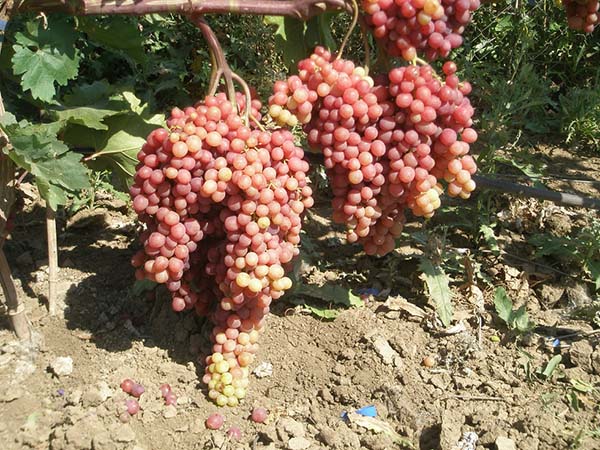
The fruits are pink with an amber tint. Berries are oval, weighing 4-5 g. Sweet taste, with an unobtrusive nutmeg aroma. The pulp is firm and crispy. The rind is thin, slightly palpable when consumed.
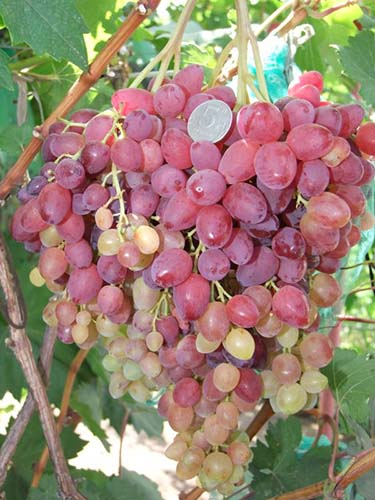
Characteristics of the Veles variety:
- ripening period - 95-105 days (very early);
- requires medium pruning of up to 6 eyes, but can be cut short.
- frost resistance up to -21 degrees.
Benefits:
- High yield, just gigantic brushes.
- Flowers are bisexual.
- Shoots ripen well.
- Suitable for long-term storage.
- Average resistance to mildew and powdery mildew (3.5 points).
There is also a stepchild's harvest on the bushes.
Disadvantages:
- After the rains, some of the berries crack.
- The bunches must be shortened, otherwise the color of the bunch is uneven.
- Often affected by gray rot.
Radiant kishmish
The variety is seedless, obtained on the basis of crossing the varieties Cardinal and Kishmish pink. Breeding "Vierul" (Moldova).
Bushes are medium and vigorous.
Leaves with a light green shade of heart-shaped, have elongated petioles. The bunches of Radiant Kishmish are medium (400-600 grams), as well as large, having a cylindrical-conical shape with expansion at the ends, up to 40 cm long and a maximum weight of 1-1.5 kg. The structure of the bunch is often medium-soft with lobes.
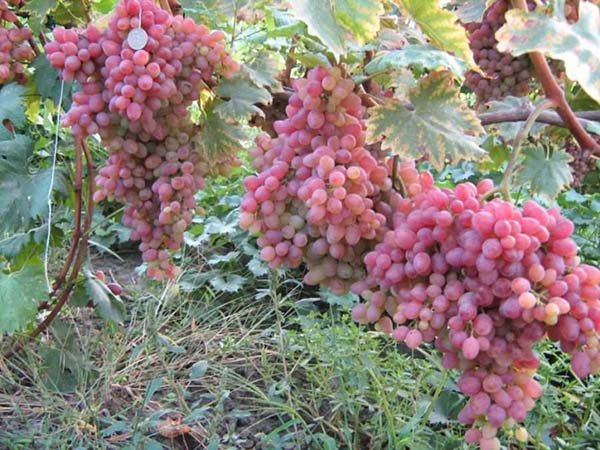
The berries initially have a golden-pink hue, but as they ripen, they acquire a red-pink color. The length of the fruits of Radiant Kishmish is 22-25 mm, the height is 17-22 m, and the weight is 2.5-4 g. Their dense flesh is characterized by a harmonious slightly nutmeg taste and aroma (it has a nightshade flavor in the background). The skin is firm, slightly palpable when consumed.
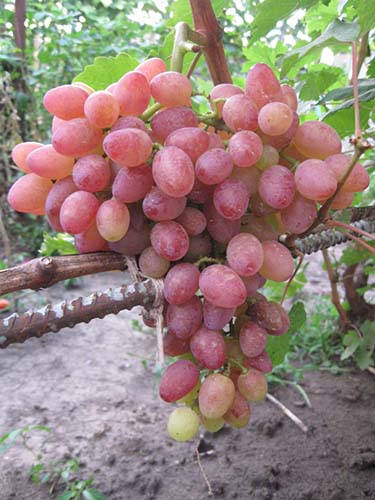
Characteristic differences of radiant kishmish:
- ripening period - 125-130 days (early-middle);
- sugar accumulation - 17-21%;
- acid content - 6-7 g / l;
- number of fruitful shoots — 50-70%;
- the number of clusters per shoot - 1.3-1.6;
- load on the bush when pruning - 30-40 eyes;
- necessary trimming - 10-12 eyes;
- frost resistance up to -21 ... -22 degrees.
Benefits:
- Bisexual flower type.
- High taste indicators.
- High marketability.
- Not damaged in transit.
- Good vine maturation.
- Not prone to peas.
- Suitable for long-term storage.
By the way! Responds very well to gibberellin treatment.
Disadvantages:
- Low resistance to fungal diseases.
- Needs rationing of the yield and constant formation of the bush.
- Demanding to agricultural technology.
Libya
The hybrid was bred by crossing based on the main qualities of the Flamingo and Arcadia varieties. Breeding "Magarach" (Ukraine), V.V. Zagorulko.
Forms vigorous plants.
The bunches of Libya are large, 25 cm or more long, cylindrical, moderately loose.
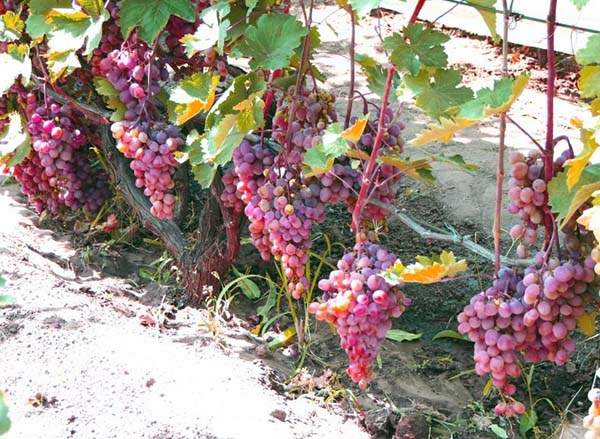
It has an uneven color - from light pink to saturated when the bunch ripens. The size of the berries is 28 mm by 18-20 mm (oval or ovoid), weight is 10-15 grams. The pulp is fleshy and juicy, the rind is not felt during use. Each berry contains no more than 1-3 seeds, which are easily separated. Libya is characterized by a pleasant taste with a nutmeg hue. The aroma lasts for 30 days during storage.
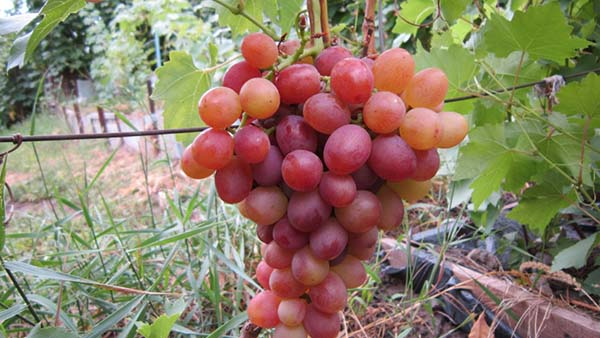
Characteristics of the variety Libya:
- ripening period - 105-110 days (very early);
- sugar accumulation - 20-25%;
- acidity - 6-7 g / l;
- the ratio of fruiting shoots is 70-80%.
- pruning shoots is recommended for 2-6 eyes.
- frost resistance up to -21 degrees.
Benefits:
- Stable yield.
- The flowers on the plant are bisexual, which guarantees a stable ovary.
- Shoots ripen perfectly.
- Excellent transportability.
- Good marketability.
Important! Saplings grow better on their own roots than on a scion.
Minuses:
- Very average resistance to powdery mildew (3.5-4 points).
- Uneven color of berries.
- Poor vine ripening at the slightest overload.
Transformation
A hybrid of grapes obtained as a result of amateur selection by V. Krainov.
Vigorous plants with a high degree of formation of stepsons.
Forms mainly shapeless and conical clusters weighing 700-1500 grams.
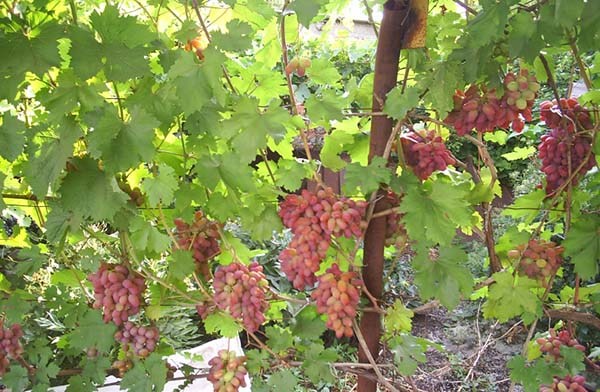
The color of the berries is from intense pink to red, more often the color is amber-pink, of an uneven color. Fruits are large, oval-elongated, weight reaches 10-14 g. Taste qualities are harmonious. The flesh of the Transfiguration is fleshy, the skin is medium-dense, but not perceptible when consumed.
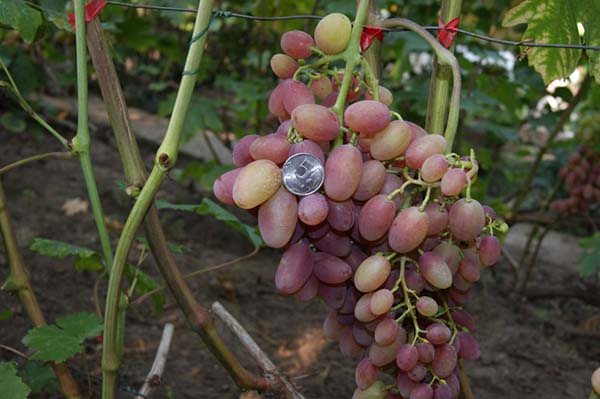
Characteristics of the Transfiguration variety:
- ripening period - 105-110 days (very early);
- sugar content - 17-19%;
- acid ratio - 6-7 g / l;
- the load of the bush with shoots - up to 30-35;
- optimal pruning by 6-8 eyes, but a good result is also obtained by pruning by 2-4 eyes;
- frost resistance up to -23 degrees.
Benefits:
- Has bisexual flowers.
- Good resistance to gray mold.
- Very high transportability and marketability.
- There is a possibility of re-harvesting on stepchildren.
- No peas.
- Good maturation of the vine.
Disadvantages:
- Very average resistance to common fungal diseases: mildew and oidium (3.5-4 points).
- Attracts wasps.
- Load rationing is required.
Important! Does not tolerate close proximity to trees and shrubs.
Somerset Seedlis
One of the best seedless varieties for northern viticulture created in the USA.
Bushes of medium to strong growth.
Bunches are small and medium (weighing 100-200 g). Dense and cylindrical.
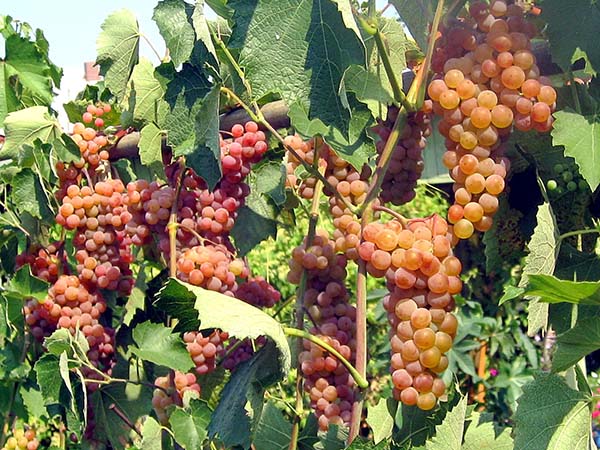
The berries are pink, small, round. The taste is pleasant, from strawberry-silk to caramel. Medium-density peel, firm, edible. Rudiments are sometimes found in fruits.
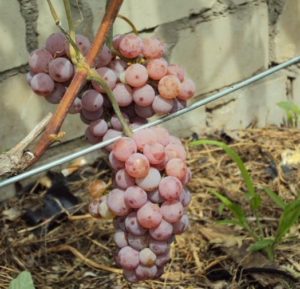
Somerset Seedles Variety Characteristics:
- ripening period - very early;
- any trimming is allowed (short, medium, long);
- frost resistance up to - 30-34 degrees.
- Very high frost resistance.
- Great taste.
- Excellent vine maturation.
- Comprehensive disease resistance.
- The yield is average.
- Very small clusters, or rather clusters.
Taifi pink (Taifi kizyl, Toipi kizyl, Toifi antimony, Gissori)
Belongs to the group of oriental (Asian) grape varieties.
Bushes are vigorous. The flower is bisexual.
The bunch is large or very large (27 cm long, 19 cm wide), conical or cylindro-conical, with very developed lateral lobes, loose. The stem of the cluster is of medium length or long (3-7 cm), lignified at the base.The average weight of a bunch is 675 g, the maximum (in Uzbekistan) is 6.5 kg.
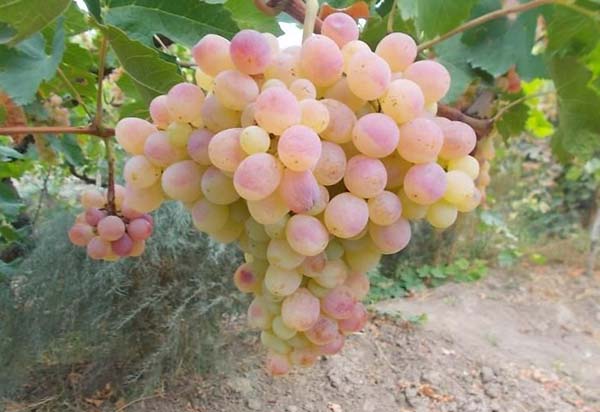 When fully ripe, berries are dark pink with a purple tint (initially yellow with purple spots), covered with a medium waxy bloom and dots. The berry is very large (27 mm long, 19 mm wide), oblong-oval or cylindrical, with a beveled top. Sometimes there is a shallow groove at the top of the grape. The average weight of berries is 4-8 g. The skin is thick, bright red on the inside. The pulp is dense, fleshy-crunchy, pleasant taste. The juice is colorless. The berry contains 2-3 medium-sized seeds.
When fully ripe, berries are dark pink with a purple tint (initially yellow with purple spots), covered with a medium waxy bloom and dots. The berry is very large (27 mm long, 19 mm wide), oblong-oval or cylindrical, with a beveled top. Sometimes there is a shallow groove at the top of the grape. The average weight of berries is 4-8 g. The skin is thick, bright red on the inside. The pulp is dense, fleshy-crunchy, pleasant taste. The juice is colorless. The berry contains 2-3 medium-sized seeds.
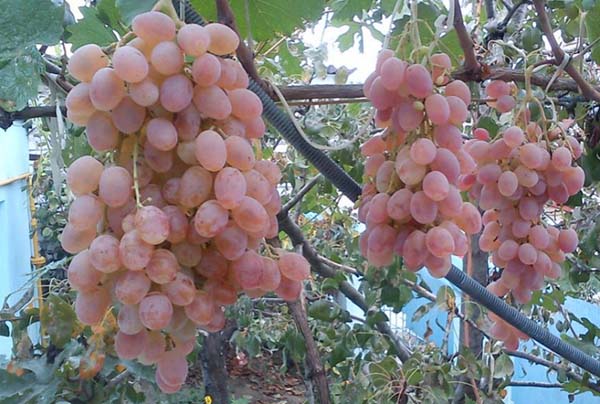
Characteristics of the Taifi pink variety:
- ripening period - 167 days (late);
- sugar content - 17.2 g / 100 ml;
- acidity - 6.5 g / l;
- the percentage of fruitful shoots - 25.6%;
- the average number of clusters on a developed shoot is 0.1, on a fruitful one - 0.7.
- frost resistance up to -15 ..- 18 degrees.
The grape variety requires formation on a high trunk with a large supply of perennial wood, long pruning of shoots.
Advantages:
- Good tasting score (7.4 points), and high in Central Asia (9 points).
- It is relatively salt-tolerant and drought-tolerant.
- Hangs on the bush for a long time without problems.
- Pulls a heavy load.
- Well stored and transported.
Disadvantages:
- Weakly resistant to mildew and oidium.
- It is damaged by a spider mite.
- Not very hardy.
Anniversary of Novocherkassk
A hybrid of complex interspecific selection by V.N. Krainova.
It is distinguished by a vigorous bush both on the grafted culture and on its own rooted one.
Forms impressive tapered brushes, medium density, the mass of which varies from 700-1700 g. But it can reach 3000 g, subject to all the rules of care.
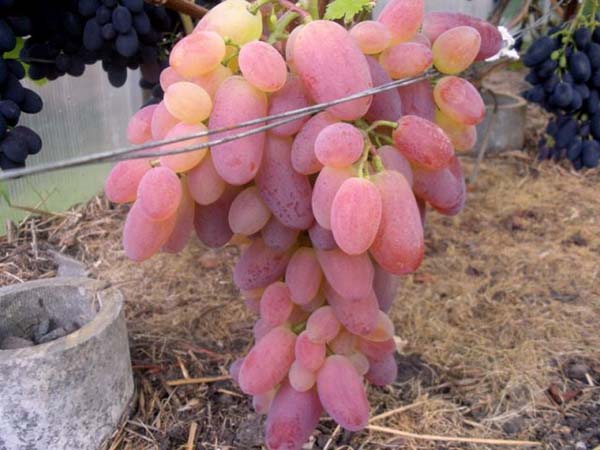
The mass of the berries is 12-18 g, the shape is elongated-oval, the dimensions are 38 by 23 mm. The pulp is characterized by a juicy dense consistency, the peel of the fruit is dense, slightly noticeable when eaten. Excellent taste (harmonious).
By the way! A distinctive feature of the Novocherkassk Jubilee (from Transfiguration and Victor) is a thinner berry.
Characteristics of the Novocherkassk Jubilee variety:
- ripening period - 110-120 days (early);
- sugar content - 16.8;
- acidity - 5.9 g / l;
- eye load - 30-45;
- pruning vines - for 8-10 buds;
- frost resistance up to -23 degrees.
Advantages:
- Contains bisexual flowers to ensure good pollination in all weather conditions.
- Shoots ripen well.
- No peas.
- Average resistance to fungal diseases (3-3.5 points).
- Transportability is good.
Important! When ripe, the berries quickly lose acidity, so they become quite edible without being completely colored.
Disadvantages:
- Normalization is required (for 1 shoot - no more than 1 bunch).
By the way! About those left behind, but not less good pink grapes, you can read in this material.
The best and most popular black table grapes: top 10
Worth knowing! Black varieties are distinguished by the content of various groups of phenolic compounds (flavonoids, anthocyanins - the higher the concentration, the darker the berries, flavonols, quinones, coumarins, resveratrol, etc.), which are the strongest antioxidants of plant origin.Therefore, black grape varieties, as well as other dark berries (the same blueberries, currants, mulberries (mulberries) and others), are considered more useful than light (white) ones.
Choosing the best black table grapes is the hardest thing, but the following are generally the most popular with winegrowers:
Academician (In memory of Dzheneyev, Academician Avidzba)
Obtained by crossing the varieties Gift Zaporozhye and Richelieu. Selection "Magarach" (Ukraine).
The bunches are large, cylindrical-conical, from loose to medium density. Weighing about 800-1000 grams.
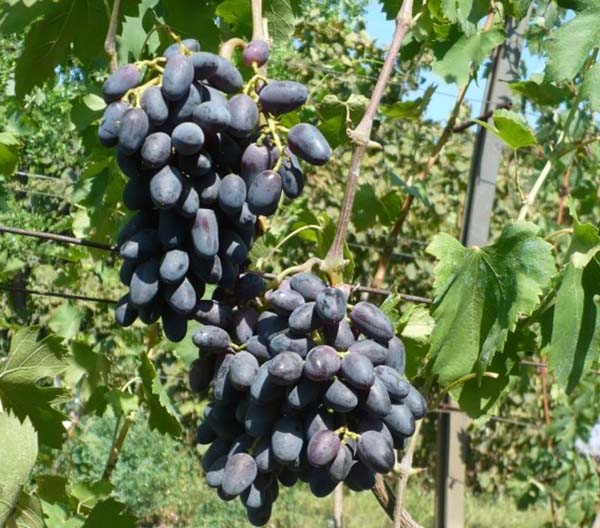
The berry is blue-black (dark blue), elongated-oval, measuring 33 by 20 mm. The skin is medium strength, the flesh is crispy. The taste is harmonious, dessert type.
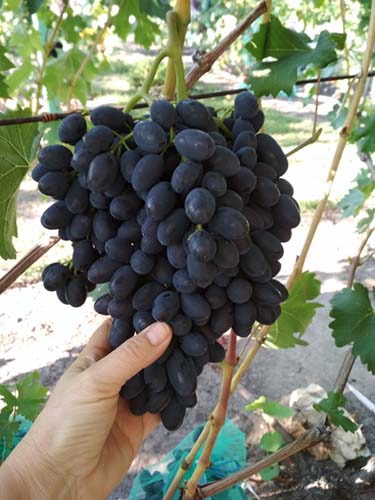
Characteristics of the Akademik variety:
- ripening period - 100-115 days (very early or very early);
- average yield - 20-25 t / ha;
- frost resistance up to -23-25 degrees.
Advantages:
- Excellent tasting score (9.8 points).
- Resistance to fungal diseases (mildew and oidium) is average.
- High transportability.
- Withstands the most severe overloads.
Disadvantages:
- Interesting wasps.
- The first bunch on the shoot has peas, the second does not. Therefore, in the spring it is necessary to remove the first inflorescence.
- Sometimes there are problems with pollination.
Athos
A hybrid form of amateur grape selection V.K. Bondarchuk, obtained from crossing the varieties Talisman and Kodryanka.
Not a bad earlier alternative to Codreanca.
Bushes above average vigor. The flower is bisexual.
The bunch is conical, large, weighing 500-700 g, medium density.
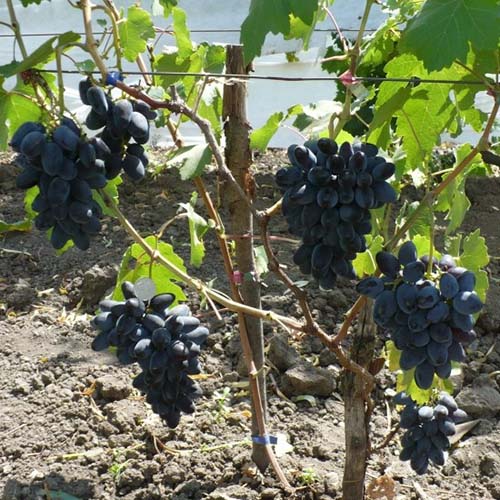
The berry is dark blue, oblong-ovoid, large, weighing 10-12 g. The skin is of medium thickness and density, the flesh is crispy, the taste is harmonious.
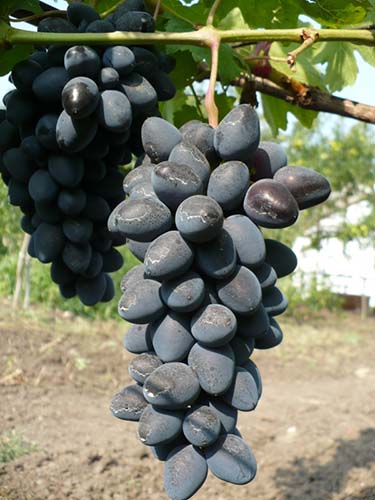
Characteristics of the Atos variety:
- ripening period - 95-100 days (very early);
- plant load with eyes - 30-35;
- pruning of fruiting vines is average - by 6-8;
- frost resistance up to -23 degrees.
Advantages:
- Increased resistance to fungal diseases (except for mildew).
- Ripening of the vine is excellent.
- Cuttings root very well
- No peas.
- Wasps are not damaged.
- Without loss of taste, it can hang on the bush for up to a month.
- High transportability.
Disadvantages:
- Often affected by mildew.
- Simple enough taste.
Great
Obtained by crossing the varieties Bolgar and Alphonse Lavalle. Bred by Ivan Todorov (Bulgaria).
The growth of the bushes is very strong (transgressive effect), which often forces the plant to form even in the year of planting. The flower is bisexual.
The clusters are large (18 x 13 cm), with an average weight of 500-600 g, from conical to cylindro-conical, loose.
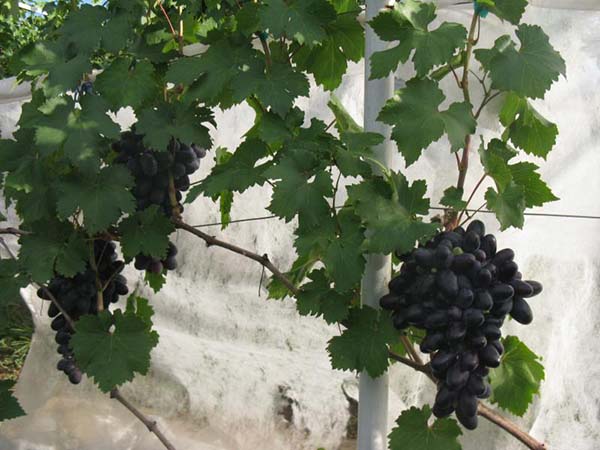
The berries are very large, with an average weight of 13-14 g (38.2x23 mm), elongated, slightly pointed towards the top, color from dark red to dark purple. The skin is thick, firm, and edible. The pulp is crispy, the taste is harmonious, reminiscent of the Bolgar variety. Seeds are medium in size, round pear-shaped, with a short beak, dark brown.
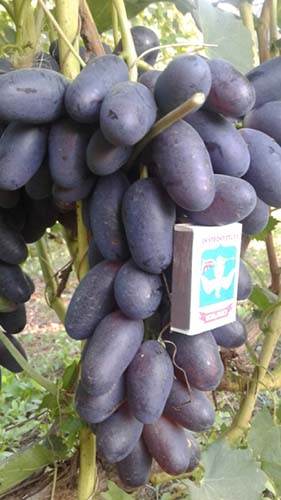
Characteristics of the Velika variety:
- ripening period - 130-140 days (average);
- yield - 9.8 kg per bush, 350 kg / ha;
- sugar content - 15-17%;
- acidity - 5 g / l;
- pruning fruit vines - 5-7 eyes;
- frost resistance up to -22 degrees.
The recommended type of shaping is a two-plane trellis.
Benefits:
- The berries do not crack.
- Wasps are not affected.
- The vine ripens perfectly.
- Disease resistance is average.
- Highly transportable.
- Stores relatively well in the refrigerator.
Has a good affinity with rootstocks CO4, 41B, Monticola. But rootstocks are recommended that inhibit the strong growth of the scion: Chassela x Berlandieri 41B, CO4, etc.
Disadvantages:
- In the north, it is highly susceptible to fungal diseases, primarily mildew.
Viking
A hybrid form of culture, obtained by crossing on the basis of the qualities of Codryanka and ZOS-1 (Red Rapture). Selections V.V. Zagorulko (Ukraine).
Differs in a very strong growth of shoots.
Forms conical clusters weighing 600-800 g, in especially fruitful years up to 1000 g. Their structure is medium-dry.

Fruits of a deep dark blue shade with a waxy coating on the skin. The berries are distinguished by a dessert flavor and a light prune flavor. Fruit weight is 8-12 g, their shape is elongated ovoid (usually 22 mm x 34 mm). The pulp has a dense juicy structure, the eaten skin is slightly palpable when eaten.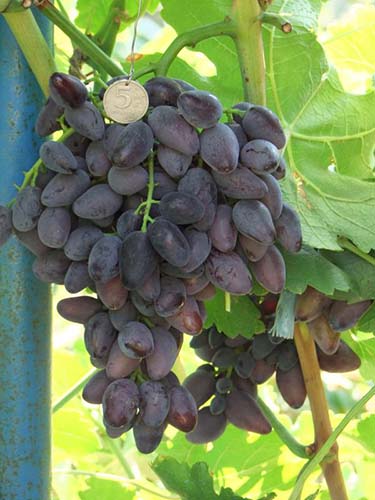
The main characteristics of the Viking variety:
- ripening period - 100-115 days (over early or very early);
- sugar accumulation - 16%;
- acid content - 4-6 g / l;
- needs a long pruning of 12-14 eyes;
- frost resistance up to -21 degrees.
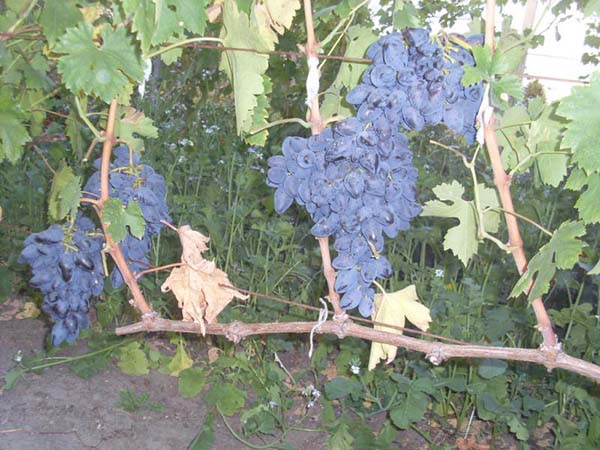
Benefits:
- Flowers are bisexual.
- It can hang on a bush and not deteriorate up to 1-1.5 months.
- High marketability.
- No peas.
- Good maturation of shoots.
- Resistance to major diseases: to mildew - 3.5-4 points, oidium - 3.0 points.
Disadvantages:
- With the enormous strength of the bush, low fertility and, as a result, poor productivity.
- Prone to cracking of fruits with increased soil moisture.
- Due to its very high growth force, it is prone to fattening and has problems with the setting of fruit buds.
Codryanka
The variety was bred by crossing the varieties of Moldova and Marshal. Breeding "Vierul" (Moldova).
It is characterized as a vigorous plant.
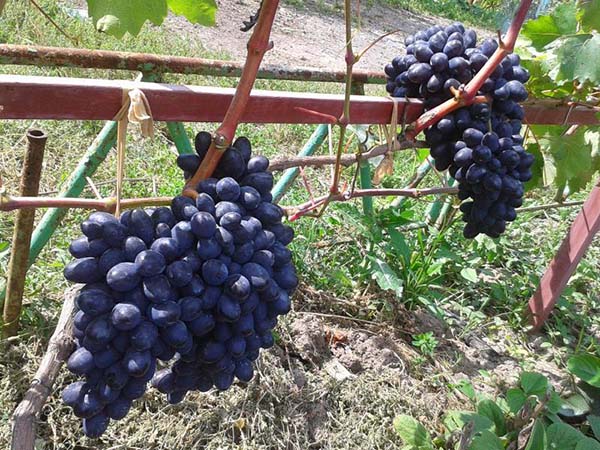
Grape clusters weigh on average 400-600 g, but there are also some up to 1200-1500 g. The structure is medium-soft (moderately dense).
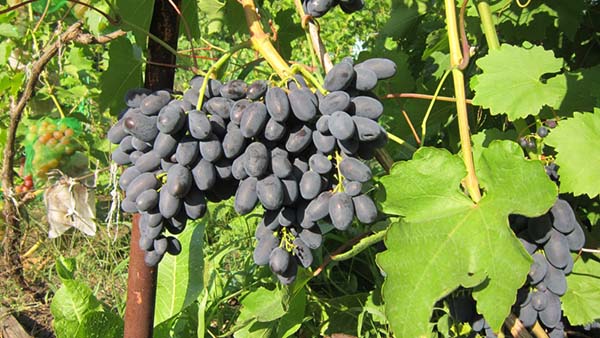
The berries are dark purple in color. Fruit weight - 6-8 g, shape - oval, average length - 31 mm, width - 19 mm. The taste is simple, but the flesh is crunchy, easily separated seeds and imperceptible rind when used together give good tasting qualities.
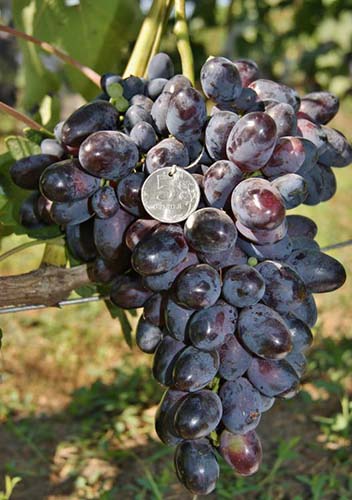
Characteristics of the Codryanka variety:
- ripening period - 110-120 days (very early or early);
- sugar accumulation - 18-19%;
- the ratio of acids is 6-7 g / l;
- fruitful shoots - 70-85%;
- the number of clusters per fruitful shoot - 1.2-1.7;
- the load on the bush during pruning is 40-50 eyes;
- trimming - for 8-10 eyes;
- frost resistance up to -22 - .. 24 degrees.
Note! Codryanka can be consumed even with incomplete accumulation of sugar in berries (12-14%), since this variety is characterized by a rapid decrease in acidity.
The advantages of the variety:
- Tasting score (8.2 points).
- Has increased resistance to gray rot, as well as to mildew and powdery mildew (3 points).
- Tolerant to phylloxera (grape aphid).
- Good maturation of shoots.
- It can hang on bushes for a long time without loss of taste.
- Excellent marketability and transportability.
- Weakly affected by wasps.
- Good keeping quality - suitable for short-term storage.
By the way! Responds well to gibberellin treatment.
Disadvantages:
- Possibly peas.
Important! It is rightfully one of the best, most popular and problem-free grape varieties.
Kuban
Obtained by crossing Moldova and Cardinal varieties. Selection AZOS (Russia).
The vigor of the bushes is above average or high. The flower is bisexual.
Bunches are very large 600-900 g, individual up to 1.5 kg, cylindrical, medium density.
The berries are dark blue, very large (30.8 x 25.2 mm), oval-ovoid, with an average weight of 6-12 g. The pulp is fleshy and juicy. Eatable peel. The taste is harmonious.
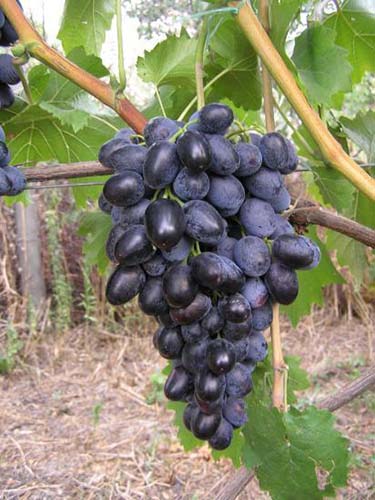
Characteristics of the Kuban variety:
- ripening period - 120-130 days (mid-early).
- sugar content - 16-20%;
- acidity - 5-9 g / l;
- fruitful shoots - 55-70%;
- the number of bunches per fruitful shoot - 1.0-1.2;
- load on the bush - 35-45 eyes;
- pruning fruit vines - for 8-10 eyes;
- frost resistance up to -22 ..- 23 degrees.
Advantages:
- High tasting score (8.4 points).
- Quite good resistance to fungal diseases (3.0-3.5 points).
- Does not burst.
- Not damaged by wasps.
- Shoots ripen well.
- It can be stored on bushes for a long time without losing its commercial quality.
- Can be used for storage.
- High transportability.
Disadvantages:
- There are small peas.
- Afraid of sunburn.
Moldova
The variety is obtained by crossing Villard Blanc and Guzal Kara. Breeding "Vierul" (Moldova).
Bushes are vigorous.
Suitable as a gazebo culture.
The leaves are rounded, five-lobed, poorly dissected. There is an edge on the reverse side of the leaf plates.
The clusters are cylindrical-conical, with an average level of density. The mass of the bunch is in the range of 400-600 g, but some are up to 1 kg.
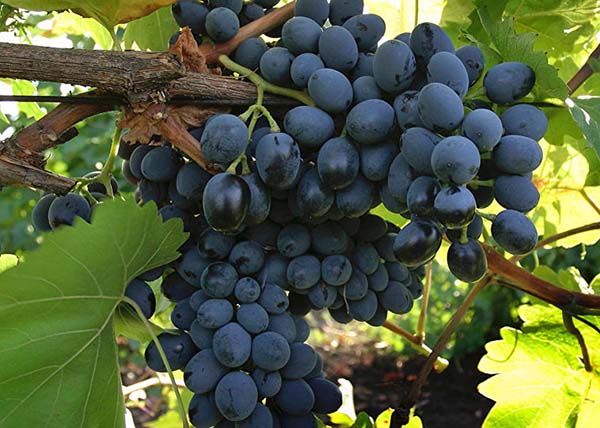
The fruits have an inky (dark purple) shade with a thick waxy coating. Berries are oval, 25 x 19 mm in size, weighing 5-6 grams. The pulp is dense, crispy, firm, and therefore felt when eaten. The taste is simple.
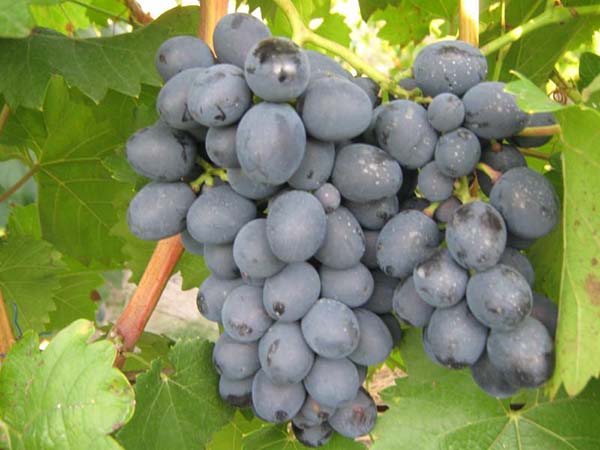
Characteristics of the Moldova variety:
- ripening period - 155-165 days (late);
- sugar accumulation -17-19%;
- acid content - 7-10 g / l;
- the ratio of fruitful shoots is 70-80%;
- the number of bunches - 1.4-1.8;
- load on the bush - 50-65 eyes;
- recommended pruning for 6-8 eyes;
- frost resistance up to -23 degrees.
Note! Moldova is not demanding on agricultural technology, but at the same time it has a high yield stability. However, with thickening of the plantings, the yield and quality of the fruits sharply decrease.
Benefits:
- Excellent tasting score (9.5 points).
- Differs in bisexual flowers.
- Begins to bear fruit early.
- Shoots ripen well.
- Resistant to mildew, gray mold, powdery mildew and phylloxera.
- Wasps are not damaged.
- Almost never peas.
- The berry does not crack under any circumstances.
- Stores well on bushes.
- High commercial quality.
- Well transported and stored.
Disadvantages:
- Susceptible to calcareous chlorosis.
- Susceptible to Phomopsis.
Nadezhda AZOS
Obtained by crossing Moldova and Cardinal varieties. Selection AZOS (Russia).
The growth force is great. The flower is bisexual.
The bunch is large and very large, weighing 600-900 g and larger. Medium density or loose, conical or branched.
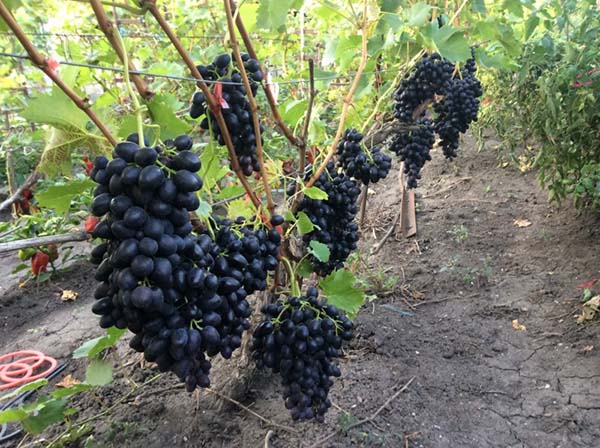
The berry is dark blue (purple), oval (29 x 23 mm), weighing 5-8 g or more. The pulp is firm and fleshy, crispy. The taste is simple but very harmonious.
Characteristics of the variety Nadezhda AZOS:
- ripening period - 120-130 days (early middle);
- sugar content - 15-17%;
- acidity - 7-8 g / l;
- fruitful shoots - 80-90%;
- the number of bunches per fruitful shoot - 1.2-1.6;
- load on the bush when pruning - 35-45 eyes;
- pruning fruit vines - for 8-10 eyes;
- frost resistance up to -22 ..- 23 degrees.
Advantages:
- Good resistance to fungal diseases (2.5-3.5 points): resistant to mildew, gray mold, increased resistance to powdery mildew.
- Ripening of shoots is good.
- Wasps are not damaged.
- It has high indicators of marketability and transportability.
- It can hang on the bush until frost, while not losing its taste.
Disadvantages:
- The cuttings are poorly rooted.
- It is prone to overloading the bush, while the clusters become smaller, normalization of the inflorescences and bunches is required.
In memory of Negrul
The variety was obtained by crossing Datie de Saint-Valier and Korn nagra. Breeding "Vierul" (Moldova).
Differs in vigorous bushes.
The size of the bunch reaches 20 cm in length, up to 12 cm in width, with a mass of 320 g, an average of 500-700 grams. The brushes are of medium density or loose.
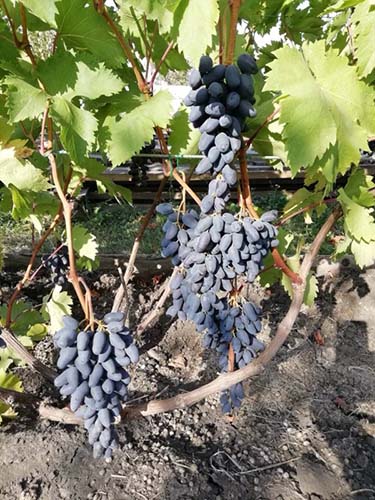
The berries have a dark purple uniform shade with a thick waxy bloom. In Memory of Negrul, berries have an elongated shape with a pointed end. Their dimensions are 30 by 19 mm, and their weight varies from 5 to 9 g. The taste is simple, but harmonious, there is a slight sourness. The flesh of the fruit is fleshy-juicy, crispy, the rind is firm and palpable, but edible. The number of seeds in a berry is about 2-3 pieces.
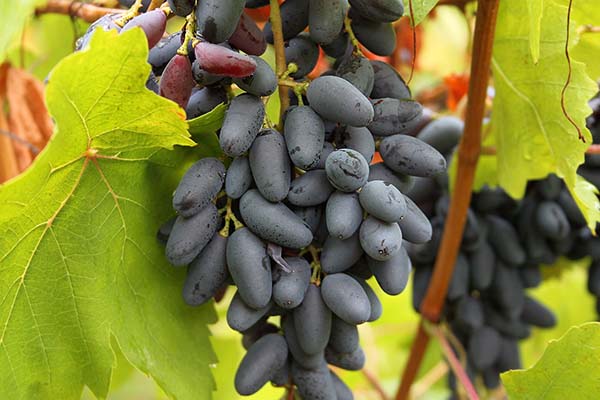
Characteristics of the variety in Memory of Negrul:
- ripening period - 145-160 days (late);
- sugar content - 14.3, but reaches 16-17%;
- acidity - 6-7 g / l;
- the coefficient of fruiting (fruiting shoots) - 60-70%;
- fertility coefficient (number of bunches per fruitful shoot) - 1.2;
- optimal load - 40-50 eyes;
- pruning vines is best done for 8-12 eyes;
- frost resistance up to -25 degrees.
Benefits:
- High tasting score (8.5 points).
- The flowers on the plant are bisexual, which guarantees a stable fruit ovary.
- Excellent presentation.
- It tolerates transportation very well.
- Stores well in the refrigerator.
- Good maturation of one-year vine.
- Wasps are not damaged.
- Possesses increased resistance to mildew, powdery mildew, gray rot
- Not affected by spider mites and leaf rollers, phylloxera.
Disadvantages:
- Demanding to agricultural technology - an increased load of eyes is required.
- Has a very brittle crest.
Rochefort
A hybrid form of amateur selection, by a complex crossing of the Talisman variety and the Cardinal variety with a mixture of pollen.
Great strength of growth. With a bisexual flower.
The bunches are medium, loose, weighing 300-400 g (individual 1 kg).
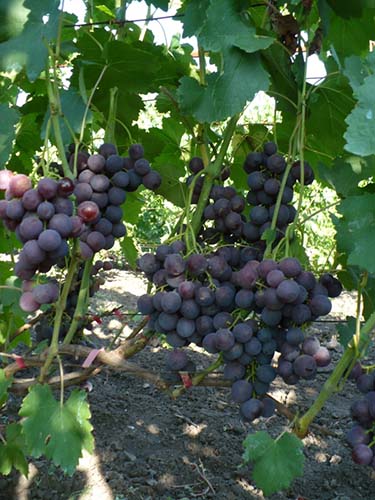
The berries are dark blue, rounded, 21.5 by 20.5 mm, with an average weight of 6-7 g (some up to 13-17 grams), Good harmonious taste, the skin is eaten, the flesh is fleshy.
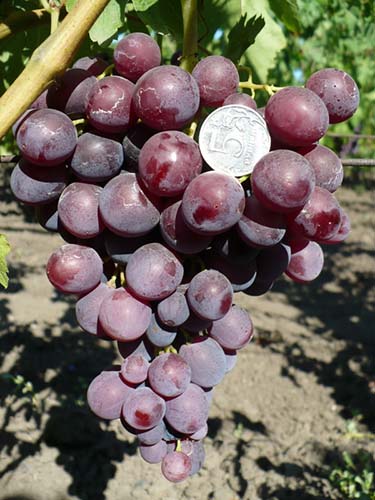
Rochefort characteristics:
- ripening period - 95-110 days (very early);
- sugar content of berry juice - 14.8 g / 100 cm3;
- acidity 5.6 g / dm3;
- frost resistance up to -15 ..- 18 degrees.
Advantages:
- Ripening of shoots is good.
- The berries can hang on the bush for a long time without cracking.
- The variety is not damaged by wasps.
- Has good resistance to mildew and gray mold.
Disadvantages:
- It is affected by powdery mildew.
Important! Read also about other equally popular black grape varieties in this article.
Well, now you just have to choose the variety you like and order it online or buy it at a garden fair (a stalk or a seedling at once). If you purchased it in the fall, thenlay the cutting for storage until spring, or be in time plant a seedling in the fall... If at the end of winter and early spring, then first prepare and germinate and then forgive the spring rooting of the cuttingor plant a ready-made seedling in open ground.


I really liked your review of the forms of grapes, the forms are disassembled and the authors are indicated. I am especially impressed by the fact that you confirm my opinion about the importance of the Athos variety, I have several bushes of it and came out on it by chance during a mass purchase at the first harvest. The author is already dead and there is no one to advertise it to the lovers of the new vine. Everyone rushed to buy varieties of Kalugin, which on a pair of Velika - Kesha chopped a couple of dozen forms. I would like to remind the author of the very good pink forms of the breeder Balabanov from the village of Starobeshevo, he has a pink non-covering - Donetsk Archny, brushes up to 1200 gr. and other forms of pink are no worse than Krainovskie. My Transfiguration is just rubbish ripening in color in mid-September, conditional marketability near Ataman Pavlyuk tears it up in all respects .. Timur is very early in white, sweet first in sales.